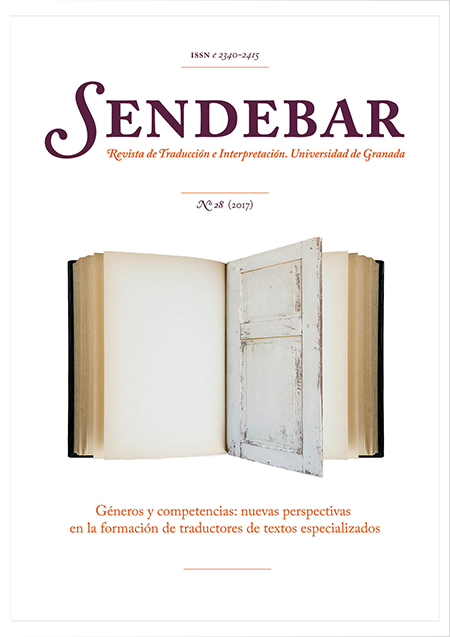La enseñanza de la traducción especializada. Corpus textuales de traductores en formación con etiquetado de errores
DOI:
https://doi.org/10.30827/sendebar.v28i0.5419Palabras clave:
didáctica de la traducción, corpus textuales de traductores en formación, etiquetado de errores, corpus bilingües, aprendizaje de lenguas a través de corpus, estadística de erroresResumen
En el presente trabajo se describe el método que se ha seguido para enseñar traducción especializada en el Máster de Traducción en Lengua Inglesa que se imparte en la Universidad de Masaryk. Tras una breve descripción de las asignaturas, nos centramos en corpus textuales de traductores en formación (translation learner corpora, TLC) recopilado en la nueva interfaz Hypal, que se puede incorporar en Moodle. Las traducciones realizadas por los alumnos se alinean de forma automática (con posibles modificaciones) y reciben un etiquetado gramatical y un etiquetado manual de errores. Es posible generar de manera sencilla informes sobre los alumnos con información estadística sobre errores en las traducciones individuales para mostrar su progreso durante el cuatrimestre o el programa completo. En función de los datos obtenidos en la prueba piloto del nuevo software, este trabajo presenta los primeros resultados del estudio a través de un corpus de traducciones de aprendices del checo al inglés.
Descargas
Citas
Bowker, Lynne and Bennison, Peter (2003). Student translation archive: Design, development and application. In Corpora in Translator Education. F. Zanettin, S. Bernardini and D. Stewart (eds.). 103-117. Manchester: St. Jerome.
Castagnoli, Sara, Ciobanu, Dragos, Kunz, Kerstin, Volanschi, Alexandra and Kübler, Natalie (2011). Designing a learner translator corpus for training purposes. In Corpora, Language, Teaching, and Resources: From Theory to Practice. N. Kübler (ed.). 221-248. Bern: Peter Lang.
Driscoll, Margaret (2002). Blended learning: Let’s get beyond the hype. E-learning 1(4), 1-4.
Espunya, Anna (2014). The UPF learner translation corpus as a resource for translator training. Language Resources and Evaluation 48(1). 33-43. doi: 10.1007/s10579-013-9260-1.
Fantinuoli, Claudio and Zanettin, Federico (2015). New Directions in Corpus-Based Translation Studies. Berlin: Language Science Press.
Fictumová, Jarmila and Rambousek, Jiří (2014). Aus den Fehlern anderer lernen. Zur Entwicklung von annotierten Übersetzungslernerkorpora. In Übersetzung als Kulturvermittlung. Translatorisches Handeln. Neue Strategien. Didaktische Innovation (83-100). Bern: Peter Lang.
Fictumová, Jarmila, Kamenická, Renata and Rambousek, Jiří (2014). Translation error typology for quality feedback: Czeching MeLLANGE through HYPAL. In Proceedings of TIFO 2014: Translation and Interpreting Forum Olomouc.
Florén, Cecilia (2006). ENTRAD, an English Spanish parallel corpus created for the teaching of translation. In Proceedings of TALC 2006: 7th Teaching and Language Corpora Conference.
Gale, William A. and Church, Kenneth. W. (1993). A program for aligning sentences in bilingual corpora. Computational Linguistics 19(1). 75–102.
Gallego-Hernández, Daniel (2015). The use of corpora as translation resources: A study based on a survey of Spanish professional translators. Perspectives 23(3). 375-391.
García Izquierdo, Isabel and Conde, Tomás (2012). Investigating specialized translators: Corpus and documentary sources. Iberica 23. 131-156.
Jaaskelainen, Riita and Mauranen, Anna (2005). 5 Translators At Work: A Case Study Of Electronic Tools Used By Translators In Industry. In Meaningful texts: the extraction of semantic information from monolingual and multilingual corpora. Barnbrook, G., Danielsson, P. and Mahlberg, M. (eds.). London: Continuum
Javora, Šimon (2016). Defining an Error Typology. Bachelor Thesis. Masaryk University, Brno.
Kübler, Natalie (2007). The MeLLange learner translator corpus (LTC) [online]. <http://corpus.leeds.ac.uk/mellange/ltc.html>
Kunilovskaya, Maria, Kovyazina, Maria and Ilyushchenya, Tatyana (2014). Error-Tagging in Russian Learner Translator Corpus and Its Classroom Applications. doi:10.13140/RG.2.1.2056.4640
Obrusník, Adam (2013). A hybrid approach to parallel text alignment. Bachelor Thesis. Masaryk University, Brno. <https://is.muni.cz/th/356468/ff_b/?lang=en>
Obrusník, Adam (2014). Hypal: A user-friendly tool for automatic parallel text alignment and error tagging. In Proceedings of the 11th international conference Teaching and Language Corpora.
Štěpánková, Kristýna (2014). Learner Translation Corpus: CELTraC (Czech-English Learner Translation Corpus). Bachelor Thesis. Masaryk University, Brno.
Sosnina, Elena P. (2006). Development and application of Russian Translation Learner Corpus. In Proceedings of the 2006 Corpus Linguistics Conference.
Tamura, Akihiro, Watanabe, Taro and Sumita, Eiichiro (2014). Recurrent Neural Networks for Word Alignment Model. In Proceedings of the 52nd Annual Meeting of the Association for Computational Linguistics (Volume 1: Long Papers). doi:10.3115/v1/p14-1138
Tiayon, Charles (2004). Corpora in translation teaching and learning. Language Matters 35(1). 119-132. doi: 10.1080/10228190408566207.
Uzar, Rafal and Walinski, Jacek (2007). Analysing the fluency of translators. Benjamins Current Topics, 135–145. doi:10.1075/bct.8.12uza.
Varga, Daniel, Németh, Laszlo, Halácsy, Peter, Kornai, Andras, Trón, Viktor and Nagy, Viktor (2005). Parallel corpora for medium density languages. In Proceedings of RANLP 2005: Recent Advances in Natural Language Processing.
Votrubec (Raab), Jiří (2006). Morphological tagging based on averaged perceptron. In Proceedings of WDS´06: Week of Doctoral Students.
Wurm, Aandrea (2013). Eigennamen und Realia in einem Korpus studentischer Übersetzungen (KOPTE). Trans-kom 6(2). <http://www.trans-kom.eu/bd06nr02/trans-kom_06_02_06_Wurm_Eigennamen.20131212.pdf>
Descargas
Publicado
Cómo citar
Número
Sección
Licencia
Terminos de Licencia Sendebar.

















